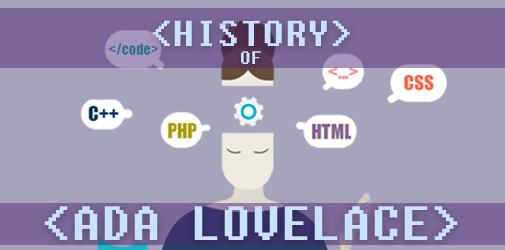
When thinking about the 19th century (decades before the computer was created) “computer programmer” isn’t necessarily the first thing that springs to mind. Yet, it was indeed the first time anyone was given that title.
Augusta Ada Byron was born into a short-lived marriage between a poet, Lord Byron, and Anne Isabelle Milbanke. When her father left, Ada was left to be raised by her mother, Lady Byron. Her mother had knowledge of mathematical teachings and insisted that Ada study the subject as well. For this time period, women studying math was considered to be highly unusual and uncommon.
At the age of 17, Ada met Charles Babbage, a mathematician and inventor, famous for his work on the first Mechanical Computer and Analytical Engine. The pair became friends, and soon after Babbage served as a mentor to Ada. Through Babbage, Ada was transferred to study advanced mathematics with University of London professor Augustus de Morgan.

In later years, Ada was assigned to translate an article on the Analytical Engine, which was written by an Italian engineer Luigi Federico Menabrea for a Swiss journal. Not only was she able to fluently translate the text from French to English, but she also added numerous thoughts and plans for the machine. Her notes ended up being three times the amount of the article itself. Her work was later published, but she never took much credit for her additions, and only added the initials A.A.L. in the publication. Babbage himself regarded of Ada very highly and often mentioned how mathematical powers were “higher than anyone he knew”.

In the notes she provided, Ada described and found methods of how codes could be created for the device to handle letters, symbols, as well as numbers. She speculated that the Engine ‘might act upon other things besides number… the Engine might compose elaborate and scientific pieces of music of any degree of complexity or extent’. The idea that a machine could manipulate symbols in accordance with rules and that numbers could represent entities other than quantity marked the fundamental transition from calculation to computation. Ada was the first to ever express such a notion and in this she appears to have surpassed even Babbage himself. Ada not only provided forward-thinking concepts in this article but, most importantly, conceived a method for the engine to repeat a series of commands. This process is known as looping, it is still used today by computer programmers. For this reason, she was named the first computer programmer.
Unfortunately, Ada Lovelace’s contributions to computer science were not discovered until the 1950s. Since then, Ada has received numerous posthumous honors for her work. In 1980, the U.S. Department of Defense named a newly developed computer language “Ada,” after Lovelace.
FUN FACT:
Ada’s mother, Lady Byron, was insistent on her daughter to learn mathematics, in order to push out the ‘poetic side’ of her father from her brain. She believed reason ruled over emotion.
Disclaimer: Any views or opinions presented in this blog post are solely those of the author and do not necessarily represent those of Aversan Inc.
About the Author
![]()
Natalia Ross is a Marketing Assistant at Aversan, with a background in Animation and Graphic design. Outside of Aversan, she has been involved in various creative, as well as medicinal projects, including Orthomolecular Research and Development, in order to provide information about benefiting and maintaining the overall health of the human body. Although her main interests reside with history, film, and literature, she is can often found working on a variety of assignments in 3D, illustration and health.
Sources
Ada Byron, Countless of Lovelace
https://www.sdsc.edu/ScienceWomen/lovelace.htmlr
The New Yorker: Ada Lovelace, the First Tech Visionary
http://www.newyorker.com/tech/elements/ada-lovelace-the-first-tech-visionary
Famous Scientists – The Art of Genius: Ada Lovelace
http://www.famousscientists.org/ada-lovelace/
Yale: Ada Byron, Lady Lovelace (1815-1852)
http://www.cs.yale.edu/homes/tap/Files/ada-bio.html

